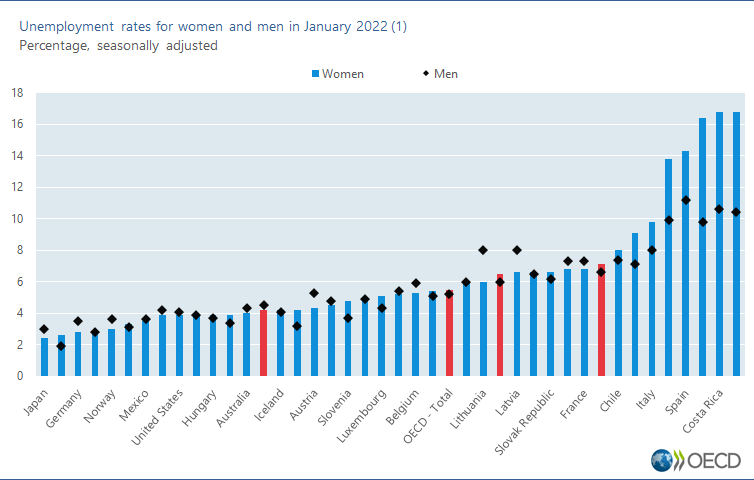Download the entire news release (graphs and tables included, PDF)
10 Mar 2022 - The monthly unemployment rate in the OECD area was stable at 5.3% in January 2022, the same rate that was recorded in February 2020 just before the pandemic (see Figure 1) and the lowest level since the start of the series in 2001. The number of unemployed workers in the OECD, at 35.9 million remained only 0.3 million above the pre-pandemic level.
In January, the OECD area unemployment rate for women declined to 5.5% (from 5.6% in December), while it was stable among men at 5.2% (see Figure 2). Nevertheless, just half of OECD countries reported a lower unemployment rate for men than women.
The OECD area youth unemployment rate (people aged 15 to 24) increased to 11.3% in January 2022, from 11.2% in December.
In the euro area, the unemployment rate fell further in January, to 6.8% from 7.0% in December 2021, with declines of 0.2 percentage point or more in Estonia, France, Italy, Luxembourg, Slovenia and Spain and rises of 0.2 percentage point or more in Greece, Lithuania and Portugal (see Table 1). In the euro area, the youth unemployment rate fell to 13.9% from 14.2% in December, continuing its downward trend.
The unemployment rate in January fell by 0.3 percentage point in Mexico and by 0.2 percentage point in Israel and Korea, while it increased by 0.5 percentage point in Canada, 0.3 percentage point in Colombia, 0.2 percentage point in Denmark, and 0.1 percentage point in both Japan and the United States. More recent data show that in February 2022 the unemployment rate declined by 0.2 percentage point in the United States (to 3.8%).
It should be noted that the unemployment rate conceals the extent of the unmet labour demand as some non-employed people may be "out of the labour force", and hence not captured by the unemployment rate, either because they are not actively looking for a job or are not available to work.
Breaks between December 2020 and January 2021 for some EU Member States resulting from changes in the EU Labour Force Survey. These breaks can affect, to some extent, aggregates for the euro area and OECD Total.
The fall in the OECD area unemployment rate when compared with the April 2020 peak should be interpreted with caution, as it largely reflects the return of temporary laid-off workers in the United States and Canada, where they are recorded as unemployed, unlike in most other countries, including European member states, where they are recorded as employed.
Link to underlying data - Source: Labour Force Statistics

1. ) December 2021 for Chile, Costa Rica, Norway and Turkey; November 2021 for the United Kingdom; fourth quarter of 2021 for New Zealand and third quarter of 2021 for Switzerland






